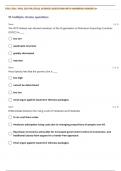Essay
Unit 21 - Biomedical Science (P1, P2, P3, P4, P5, P6, M1, M2, M3, M4, M5, D1, D2, D3, D4, D5)
- Module
- Unit 20 - Biomedical Science
- Institution
- PEARSON (PEARSON)
This unit covers all the criteria to achieve distinction. My overall grade for the BTEC Level 3 Extended Diploma in Applied Science was D*D*D*.
[Show more]












